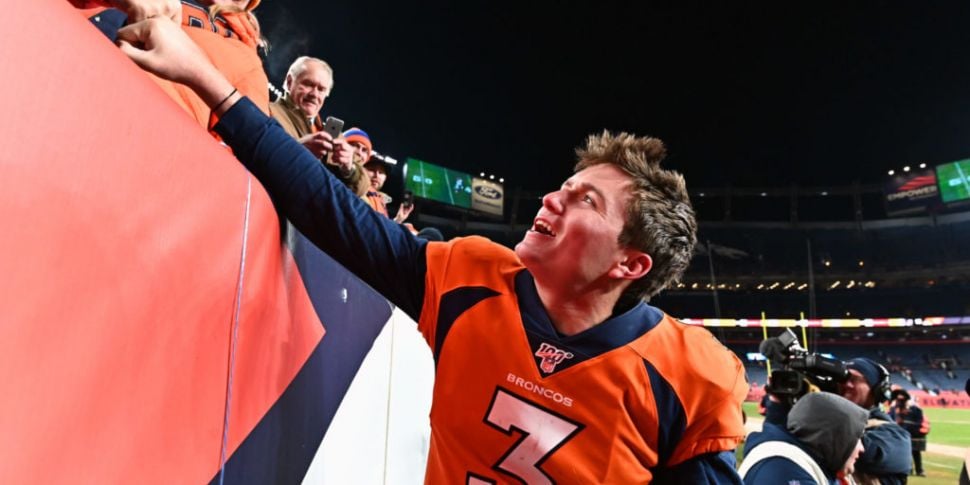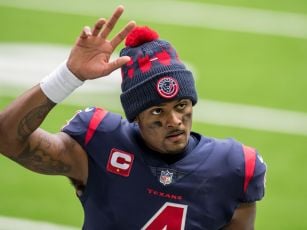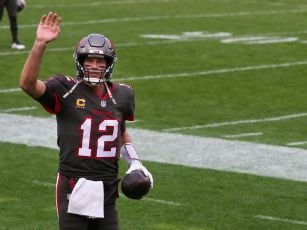Drew Lock wasn't a top prospect in the 2019 NFL Draft. He wasn't necessarily a popular pick when the Denver Broncos selected him 42nd overall. But Lock's rookie season proved to be a massive success once he saw the field. Now he's promising big things in 2020.
Drew Lock can save John Elway further embarrassment. Elway runs the Denver Broncos. He wanted to trade for Colin Kaepernick prior to his final year with the San Francisco 49ers. Kaepernick was available for free a few months later. Elway passed. His excuse was that Kaepernick had his chance. Funnily enough, Elway was happy to bring back Brock Osweiler who had ignored Elway's call when he hit free agency previously.
Elway embarrassed himself with Kaepernick.
But that wasn't his only mistake. Despite being a Super Bowl-winning quarterback in his past life, Elway has repeatedly made the wrong choice at the position. First, it Was Brock Osweiler, then Trevor Siemian, then Paxton Lynch, then Brock Osweiler again, then Case Keenum, then Joe Flacco. After winning the Super Bowl in 2015, the Broncos slumped to a 23-36 record over the following 3.5 seasons before Drew Lock took over in 2019. The Broncos went 4-1 with Lock.
Win-Loss records don't mean anything for individual players. They especially don't mean anything over a small sample. Lock hasn't proven himself as anything yet in the NFL. But as a rookie, he did everything he possibly could have to give the Broncos reason for hope. Lock played the best football Broncos fans have seen since Peyton Manning in 2014.
The NFL as a whole has an affinity for tall, white, big-armed quarterbacks. It's the prototype in the league because of how the culture has never evolved past conventional wisdom. That conventional wisdom was built through racist structures that squashed black quarterbacks out by propping up subpar white quarterbacks. It's why the NFL draft coverage often includes discussion about quarterbacks as the face of the franchise and it's why such professional commentators as Colin Cowherd can become parodies of themselves in the most serious of manners.
Elway has been at the forefront of that type of decision making. Paxton Lynch's biggest achievement in the NFL was his headshot.
Lock was the 42nd-pick of the 2019 draft. His selection was met with a collective eye-roll from NFL onlookers. It appeared that Elway was just adding another big, white guy with a big arm who couldn't actually play the position. Lock's college tape didn't suggest otherwise. His debut during his rookie season inspired no confidence either. Lock was rattled in his debut. He never got to the speed of the game and played tentatively as a result.
That's not unusual. Deshaun Watson had a similar debut against the Cincinnati Bengals years ago. After his debut in Week 13, Lock was one of the best quarterbacks in the league. He showed off a broad skill set. He used his athleticism intelligently and understood the nuances of the position to execute at a high level.
A good month means nothing to an established veteran. But for a rookie who only started five games, a good month is a glimpse into what could be.
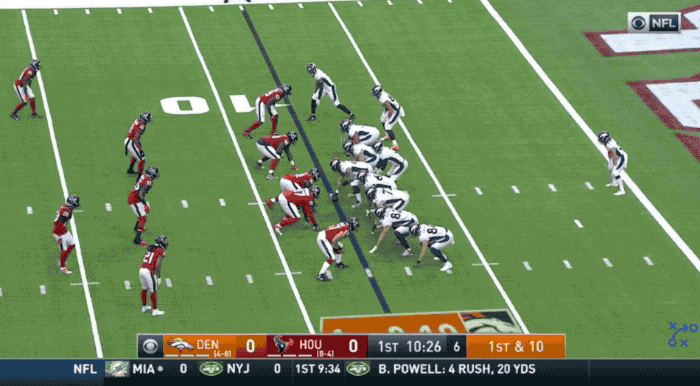
One big concern for Lock in his second season is the coordinator change. Rich Scangarello's offence perfectly suited Lock's skill set. It also means he has to learn a new scheme, this threatens to throw Lock's development off-kilter, something that was a factor in Mitchell Trubisky's regression in Chicago. On the offence's first play of the game against the Texans, Scangarello called a shot play.
This is a simple, safe play design for the quarterback. The hard play fake moves him to the narrow side of the field. He has three receivers running routes, one deep, one intermediate and one in the flat. All three are in line with each other, meaning Lock only has to concentrate on one area of the field.
He can see everything he needs to see in one line of vision.
Although he had an opportunity to hit Courtland Sutton deep, Sutton was level with a defender and began to pull away after the ball left Lock's hand, the quarterback passed him up. Sutton one-on-one in that scenario should be thrown to. Instead, Lock looked at Noah Fant, whose defender had anticipated the route so was jumping onto his outside shoulder.
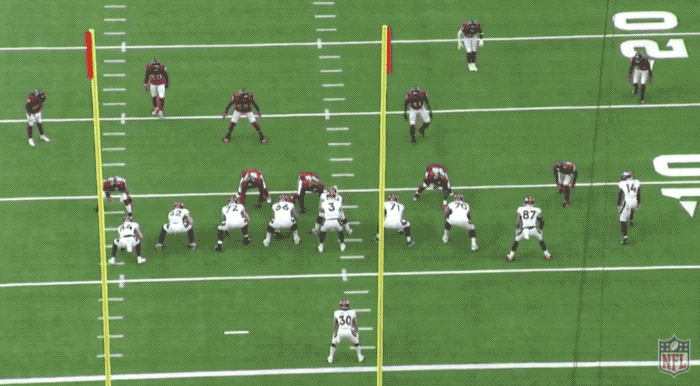
Although Lock probably made the wrong decision on this play, it's his awareness to place the ball on his tight ends' inside shoulder that stands out most. The awareness to see the route developing and understanding of what constitutes an accurate pass in that scenario is rare for a young quarterback. An out route typically means through the ball in front of your intended target, but that's not the case when the defender is already outside.
Fant is able to turn upfield for a huge gain because of the ball placement he was given.
Furthermore, despite the hard play fake and the seven-man pass protection. Lock had to get the ball out before interior pressure got home. He stood strong and delivered the ball with full commitment before absorbing a heavy hit from the defensive lineman.
This was far from an easy play in the end, despite the safe play design. After a three-yard running play, Lock made another play against pressure to generate a big gain.
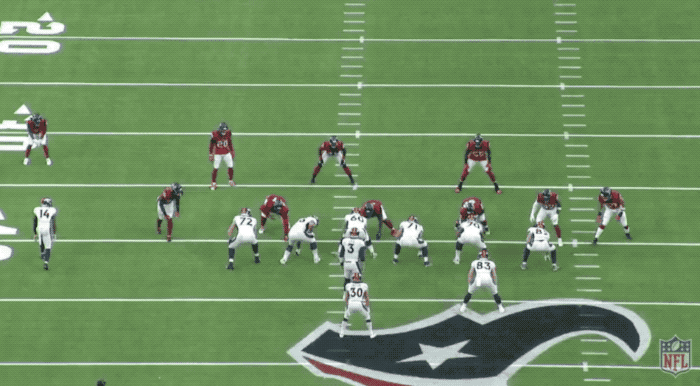
Play action is used again, but it's a very different type of play fake this time. Lock is in shotgun and uses a subtler play fake before getting into his drop. The Texans were attempting to intimidate the inexperienced passer with their initial alignment. They didn't have a deep safety at first, keeping extra defenders in the box before one broke off to the middle of the field.
This is an important detail for Lock's processing once he has the ball in the pocket. The Texans blitz from the left and the defender comes clean. Lock has a small window to hit. He has to hold the ball long enough for his receiver on the left to clear out space for his crossing route to get open. But he can't hold the ball so long that the free blitzer gets to him.
He backs up to buy time but doesn't lose his balance or concentration while doing so.
Making this play requires poise and concentration under pressure. Lock has to be able to keep his eyes up and not lose his mechanical discipline to comfortably deliver the ball downfield. He gives an accurate pass and takes another necessary hit after releasing the ball.
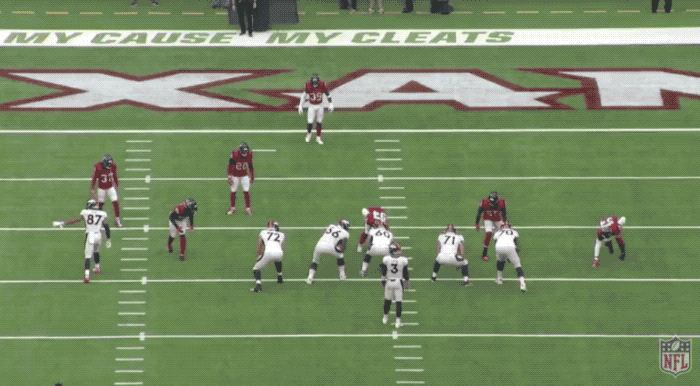
Sticking with the same drive, Lock eventually finds himself in a Third-and-12 situation in the redzone. The Texans again attempt to confuse him before the snap. This time there is a single-high safety initially, before a second defender rotates back. Despite that rotation, the initial single-high defender doesn't split the difference and move to his left. He only commits to that side once the ball is snapped.
Lock checked that safety's rotation at the snap, then located Fant running down the seam.
He correctly diagnosed the coverage and hit his receiver at the right time with a perfect throw. His pass cleared the defender trailing Fant and didn't ask the tight end to reach for the ball. By checking the safety rotation initially, Lock prevented both deep defenders from closing space to impact the catch point.
This was a straight dropback against a four-man rush behind the down-and-distance. The Broncos spread the field out to create space and simplify his read, but the defence did what it could to confuse him and failed. This was a high-end play for a rookie quarterback.
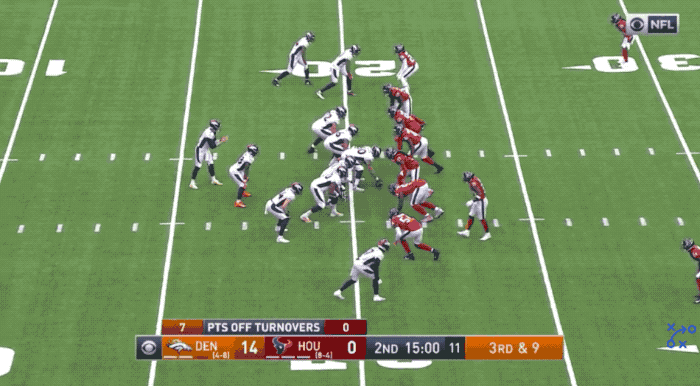
For the first play of the second quarter, the Texans again disguised their coverage but not aggressively. They kept their deep safety down and to the left side of the offence before rotating him to the deep middle at the snap. Tim Patrick ran a wheel route against press-man coverage from the slot. With the deep safety in the middle of the field and the defence blitzing, Lock knew he was his outlet.
He also knew he had to let that route develop for a moment. He angled to his left and dropped back while the interior of the pocket collapsed. That moved him to a more vulnerable position for the right-side defensive end, but Lock knew he could get the ball out on time. He also knew he could make the throw against pressure.
It's a 34-yard throw where the ball has to be put on the outside line to protect the receiver from the deep safety.
Releasing the ball while moving backwards made this a very difficult throw. Lock has to generate enough velocity to clear the trailing defender and he has to control the placement so that the ball doesn't drift away towards the middle of the field. It's a very dangerous pass to attempt. He executed it perfectly.
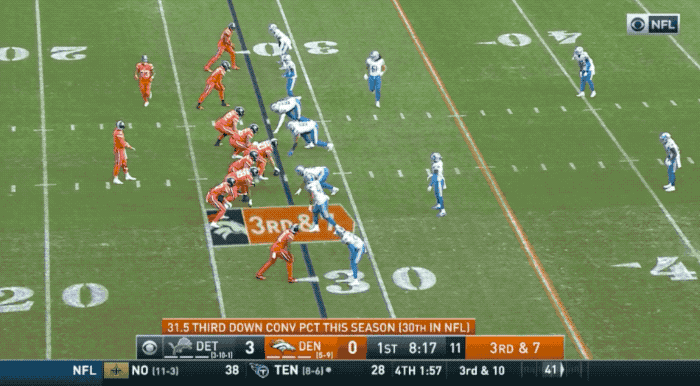
On this Third-and-7 early against the Detroit Lions, Lock hits Devontae Booker with a perfect throw against man coverage. The Broncos used motion before the snap. When the defender followed Booker from out wide into the middle of the field, Lock knew to expect man coverage. The defence was already showing him two deep safeties prior to the motion.
Two deep safeties playing zone with man coverage underneath would have made sense in this scenario. The offence was behind the down-and-distance so the defence wasn't concerned about any running play.
When the play begins, the Lions rotate their safeties so that one comes down to double team Sutton. With Sutton occupying two defenders, the defence can't be playing two safeties deep and man underneath. They've rotated to a single-high safety defence. Lock instantly understands that the matchup to attack now is Booker against the linebacker.
Lock's pass is perfect but Booker's ball skills lead to an incompletion.
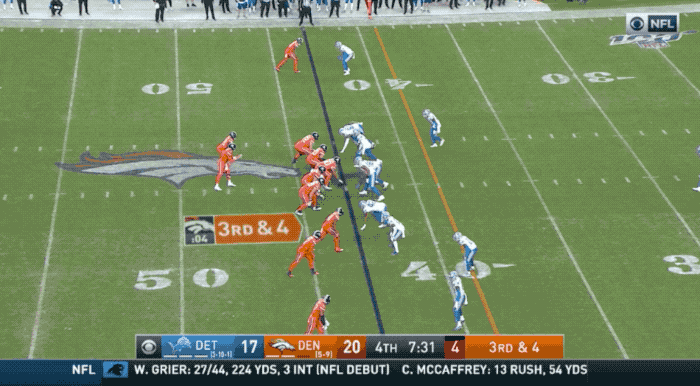
Lock proved to be a smart pre-snap and post-snap passer. His intelligence allowed him to maximize the windows that he was throwing into. It was difficult for defences to blitz him or bait him into bad throws. He had his share of rookie errors, but not enough to be concerned. The above play shows off his timing against the blitz.
This isn't an easy throw. The ball has to arrive at the right time. Lock is aided by having a strong arm. He pushes the ball wider than the defensive back and puts some height on it to make sure it clears the defender if he reaches in front of Tim Patrick.
Lock generates velocity without any strain.
His arm isn't on Derek Carr or Patrick Mahomes' level. He has a very impressive arm, but to have one of the best arms in the NFL in this era you have to be special. Lock can make any throw he needs to make. His athletic profile is rounded. He's strong, agile and balanced moving left or right. That allows him to be an effective passer from either flat.
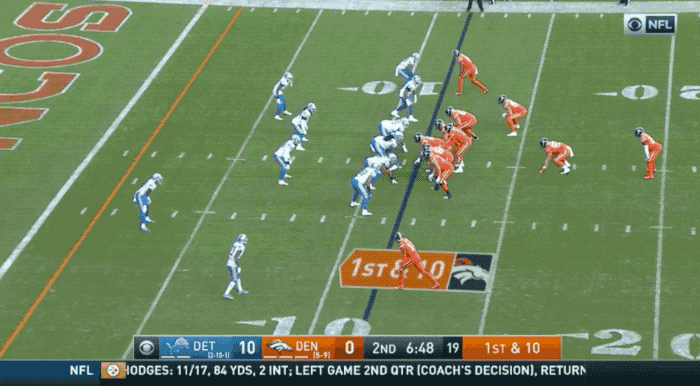
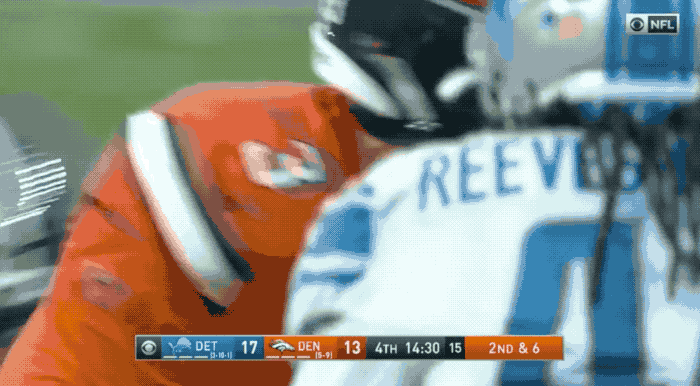
Scangarello's offence is a version of Kyle Shanahan's offence. Scangarello was the quarterbacks coach for Shanahan in San Francisco before joining the Broncos. As Jimmy Garoppolo has highlighted lately, Shanahan's offences feature a lot of bootleg play fakes. Getting Lock on the move is maximizing his skill set. Pat Shurmur will use plenty of play-action and misdirection, but the play designs aren't as crisp.
Lock's poise and athleticism can work together on straight dropbacks too.
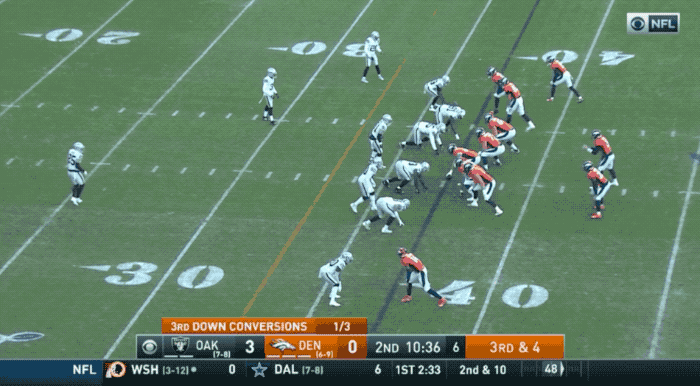
On this play, the Broncos use a mesh passing concept which means they have receivers crossing each other in the middle of the field. The Raiders had the ideal defence called to take away Lock's options. At the same time, the left defensive tackle on the Raiders defensive line is far too aggressive in his pass rush. He gets onto the right guard's outside shoulder before pushing upfield.
This creates a running lane for Lock to escape through. He extends the play into the flat, keeping his eyes downfield, before connecting with Sutton for the first down.
That's creating outside of structure, something Lock figures to be very good at moving forward.
Every rookie season comes with a warning label. These are players at a sensitive stage of their careers. Any major positives or major negatives have to be viewed in the context of development. Mitchell Trubisky's rookie season was very impressive, if you go back and watch his tape now you'll see everything you need to see from a rookie, but he dropped off after that. Jared Goff's rookie season was disastrous. He became a decent starter then.
None of us can know if Lock is the next Lamar Jackson or the next Baker Mayfield. Broncos fans hope its the former. But so far, he's done everything he possibly could have besides falter in that first game to suggest he's going to be good.
He's definitely capable of being a star in the NFL.
Read more quarterback breakdowns on Off The Ball:
Aaron Rodgers is still an elite quarterback.
Baker Mayfield will be a liability again in 2020.
Ryan Tannehill's success is unsustainable.
Deshaun Watson is on the precipice of greatness.
Download the brand new OffTheBall App in the Play Store & App Store right now! We've got you covered!
Subscribe to OffTheBall's YouTube channel for more videos, like us on Facebook or follow us on Twitter for the latest sporting news and content.

